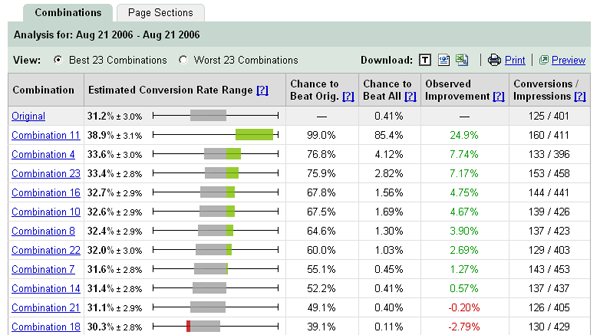 Testing email subject lines and content is pretty easy with many email marketing tools, but there was never an easy way to do the same thing with webpages...until Google Optimizer.
Testing email subject lines and content is pretty easy with many email marketing tools, but there was never an easy way to do the same thing with webpages...until Google Optimizer.
I first heard about Google Optimizer from an Obama Campaign veteran and have become a big fan. To use it, you create a webpage and variations of that page that you'd like to test (for example, you might want to test if people respond better to a picture of a polar bear or a happy child on your donation page). You then set up an "experiment" on Google Optimizer where you tell it what the test pages are and what the conversion page is (such as the "thank you" page if you're testing your donation process).
The amount of time to get results will depend on the traffic to the page, but Optimizer will soon generate a report about which variation performed better, and you can easily shift your traffic to the winner. Here's a sample report:

Google Optimizer also allows for "multivariate testing". From Google: "Multivariate tests... allows you to test multiple variables -- in this case, sections of a page -- simultaneously. For example, you could identify the headline, image, and promo text as parts of your page you'd like to improve, and try out three different versions of each one. Website Optimizer would then show users different combinations of those versions (let's say, Headline #2, Image #3, and Promo Text #1) to see what users respond to best. Multivariate tests are more complicated, and typically require higher page traffic."
You can test out page content, design choices and site-wide content. Properly used and paired with your existing website analytic solution (whether Google Analytics or another real-time solution like Woopra), Google Optimizer becomes a useful addition to your bag of tricks. But there are some things to look out for:
- "Let's just test it" culture: If you have a team where you actively debate the merits of different design choices, this new functionality could be abused since some people might say "let's just test it" when there is a disagreement. The lead designer of Google left because he was frustrated by their over-obsession with testing and data. As he said: "Yes, it’s true that a team at Google couldn’t decide between two blues, so they’re testing 41 shades between each blue to see which one performs better."
- Return on Investment (ROI): With the ability to test pages so easily, you'll be tempted to spend a greater chunk of time testing different pages. Heather Holdridge's great article about the ROI for social media raises points that are relevant here to. Sure, you can test every page and every possible configuration, but there are diminishing returns.
- False promises: When you optimize around a given conversion, there is a risk that you might be hurting long-term results without realizing it. Think about a site that gave you misleading or wrong expectations. Sure, they got you to subscribe initially, but you soon unsubscribed and lost respect for the organization.
To avoid these pitfalls, I'd recommend:
- Develop a hypothesis and then test it: Before starting, come up with a theory and then test it. For example, the theory might be "users will prefer fewer choices than a large selection because it will be easier to figure out the best option" and then design a test that will see whether that is true. Using this approach, you can develop guidelines that will help you in future work instead of one-off factoids ("They liked the blue line better than the red line"). Don't be afraid to test your hypothesis again in the future (other factors might be at work).
- Be selective: Look at your priorities and website analytics to figure out which pages are worth testing. I think you'll discover that testing your Privacy Policy won't be a good use of your time.
- Track your results: Be sure to keep track of your theories and the supporting analyses so you don't have to repeat experiments each time.
- Tag people: Be sure to set up a tagging system for your database so you can see the performance of the users over time.
Google Optimizer functionality is especially powerful for important pages like donations or signups. It might take a bit of work to perform and analyze the tests, but you'll rest easier knowing your donation pages are performing really well. Oh, and did I mention that it's free?
You can check out Google Optimizer here.
This article was written by Matt Howes, who leads Arcadia Campaigns, a consulting company that helps progressive non-profits succeed online.


COMMENTS